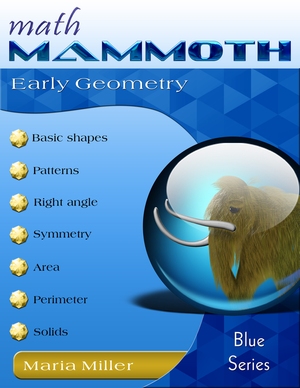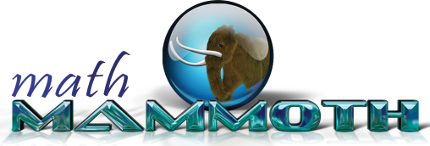Math Mammoth Early Geometry

137 pages
(answers included)
Sample pages (PDF)
Contents
Drawing Basic Shapes
Solids
Area of Rectangles
More About Perimeter
Prices & ordering
PDF download USD $8.10
You will be purchasing the downloads from my authorized reseller Comecero.
Printed copy $13.10
 Este libro en español
Este libro en español
Math Mammoth Early Geometry is a worktext that covers geometry topics for grades 1-3.
The first lessons in the book have to do with shapes. Children learn to identify and draw basic shapes. Using cut-out shapes, they put several shapes together to form new ones. They also divide existing shapes into new ones by drawing a line in shapes.
Students also explore some geometric patterns and make shapes in a tangram-like game. These topics provide some fun while also helping students to memorize the terminology for basic shapes.
Starting from the lesson Polygons, the lessons are for third grade level. In the first three lessons of this section, students sort shapes into categories based on their attributes, and learning, in particular, about quadrilaterals as a category. Students observe attributes such as the number of sides, presence of right angles, and whether the shape has equal sides or not. They learn about rhombuses, rectangles, and squares, and how a square is also a rectangle and a rhombus.
Their work here prepares students to classify quadrilaterals in great detail in grade 5. Students classify figures in grade 4 also, based on angles, and focusing on triangles in particular.
Next, we focus on the area of rectangles and shapes composed of rectangular areas. (How to calculate the area of other common shapes, such as triangles, polygons, and circles, is studied in 6th and 7th grades.)
We start the topic with the lesson Getting Started with Area, where students tile shapes with unit squares cut out of paper, thus learning the foundation of how area is measured. From there, the lessons gradually lead to the thought that area of a rectangle can be found by multiplying its side lengths. Students learn about different units for area (both metric and customary) and get hands-on experience on finding the area of rectangles by measuring the sides in inches or centimeters.
Then the lessons deal with the area of compound (rectilinear) shapes, whose area can be found by decomposing the shape into (non-overlapping) rectangles.
In this context, we also study the distributive property in disguise, in the lesson Area of Decomposed Rectangles. A rectangle is divided into two parts, and its area is found in two different ways: either as the area of the entire rectangle, or by adding the areas of the two parts.
From this area model, we can see that a × (b + c) is equal to a × b + a × c. The expression a × (b + c) is the area of the entire rectangle, with side lengths a and (b + c), and this is equal to the sum of the areas of two rectangles, one with sides a and b, and the other with sides a and c. (The images in the lesson make it more clear.)
The distributive property is studied in its algebraic form in 6th grade, but students will use it again in 4th grade in the context of finding common factors of two whole numbers. For example, they will express the sum 36 + 8 as 4(9 + 2).
In the lesson Multiplying by Whole Tens students learn to multiply a single-digit number by a multiple of ten, for example 3 × 40 or 90 × 7. After that, students use this skill to calculate areas of bigger rectangles in the rest of the lessons in the book.
The last major topic in the book is perimeter. Students learn perimeter as the “go-around measure”: the total distance when you go or travel around the shape. Then, several lessons focus on both area and perimeter, to make sure students learn to distinguish between these two concepts. We investigate rectangles that have the same area but different perimeters, and also rectangles that have the same perimeter but different areas.
Good Mathematical Practices
- Encourage and require students to include the proper unit for area and for perimeter in their answers. Area is measured in square units of some kind (e.g. square meters, square inches), whereas perimeter is measured in linear units (e.g. meters, inches). Giving a numerical answer only (e.g. “24”) is not totally accurate. Remembering to include the proper unit is part of learning to convey mathematical results in a precise manner.
- While the geometric word problems in this book are still very simple, it is a good practice for students to learn to draw a sketch of the figure in question. With more complex problems in later grade levels, drawing a picture of the shape(s) becomes an essential tool in one’s “mathematical toolbox”.
- The area of a rectangle is found by multiplying the side lengths. The area model becomes an important tool in subsequent grade levels in the context of multiplying multi-digit whole numbers, multiplying mixed numbers, and even in multiplying polynomials in algebra.
- The lessons Polygons and Multiplying by Whole Tens give students opportunities to look for structure in sorting shapes and for numerical patterns. Mathematics has been called the “science of patterns”, so these types of tasks have to do with the essence of mathematics.
- Note that when a problem asks for the area or a perimeter of a figure in centimeters, millimeters, or inches, and the figure does not indicate the side lengths, the student is supposed to use a ruler to measure. By not including that instruction in the problem, we are giving the student opportunity to reason out the need for a ruler as a tool.
This book is also suitable for a geometry notebook or journal project. This simply means that for each new TERM in the book, the student explains that term and draws the corresponding figure, using 1-2 blank pages. In the end, the student will have their very own geometry book to keep and show around!
After studying the lessons in this book, students can continue the study of geometry with Math Mammoth Geometry 1.
The PDF version of this book can be filled in on a computer, phone, or tablet, using the annotation tools found in many PDF apps. See more.
Better Yet - Bundle Deals!
Blue Series - $165 (download)Blue Series for grades 1-3 - $49 (download)
Blue Series for grades 4-5 - $47 (download)
Blue Series for grades 6-8 - $69 (download)
Light Blue Series, grades 1-8 - $225 (download)
Light Blue Series, grades 1-4 - $112.50 (download)
Light Blue Series, grades 5-8 - $112.50 (download)
All Inclusive Bundle - $275 (download)
"Everything" Bundle - $330 (download)
Learn more about the bundles!
*BONUS*: Buy any bundle listed above, and get the fully upgraded Soft-Pak software for FREE (includes 4 math and 2 language arts programs, complete with on screen and printable options).
How and where to order
You can buy Math Mammoth books at:
- Here at MathMammoth.com website — simply use the "Add to cart" buttons you see on the product pages.
- Rainbow Resource carries printed copies for the Light Blue series books, plus several CDs (Light Blue and Blue series).
- Homeschool Buyers Club offers download versions of the Light Blue series, plus the Blue series bundle.
- Homeschool Planet sells the digital versions of the main curriculum and lesson plans to go with them.
- K5 Learning offers download versions of the Blue series.
- TPT sells the Light Blue Series downloads, plus topical units.
- Lulu sells printed copies for most of the Math Mammoth materials (various series).
By purchasing any of the books, permission IS granted for the teacher (or parent) to reproduce this material to be used with his/her students in a teaching situation; not for commercial resale. However, you are not permitted to share the material with another teacher.
In other words, you are permitted to make copies for the students/children you are teaching, but not for other teachers' usage.
Math Mammoth books are PDF files. I recommend you use Adobe Reader to view them, including if you use a Mac. You can try other PDF viewers, but they may at times either omit or mess up some of the images.
Receive my monthly collection of math tips & resources directly in your inbox — and get a FREE Math Mammoth book!
You can unsubscribe at any time.
Math Mammoth TourConfused about the different options? Take a virtual email tour around Math Mammoth! You'll receive: An initial email to download your GIFT of over 400 free worksheets and sample pages from my books. Six other "TOURSTOP" emails that explain the important things and commonly asked questions concerning Math Mammoth curriculum. (Find out the differences between all these different-colored series!)This way, you'll have time to digest the information over one or two weeks, plus an opportunity to ask me personally about the curriculum. A monthly collection of math teaching tips & Math Mammoth updates (unsubscribe any time) We respect your email privacy.
Note: You will FIRST get an email that asks you to confirm your email address. If you cannot find this confirmation email, please check your SPAM/JUNK folder. |
"Mini" Math Teaching CourseThis is a little "virtual" 2-week course, where you will receive emails on important topics on teaching math, including:
- How to help a student who is behind You will also receive: A GIFT of over 400 free worksheets and sample pages from my books right in the very beginning.We respect your email privacy.
Note: You will FIRST get an email that asks you to confirm your email address. If you cannot find this confirmation email, please check your SPAM/JUNK folder. |
Maria's Math TipsEnter your email to receive math teaching tips, resources, Math Mammoth news & sales, humor, and more! I tend to send out these tips about once monthly, near the beginning of the month, but occasionally you may hear from me twice per month (and sometimes less often). Peek at the previous tips here. You will also receive:
We respect your email privacy.
|
|
